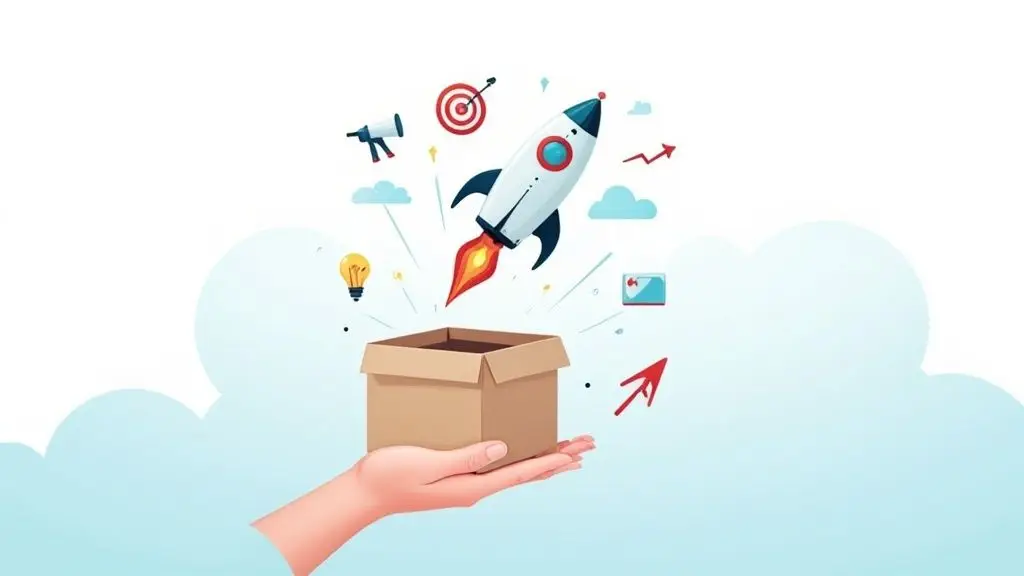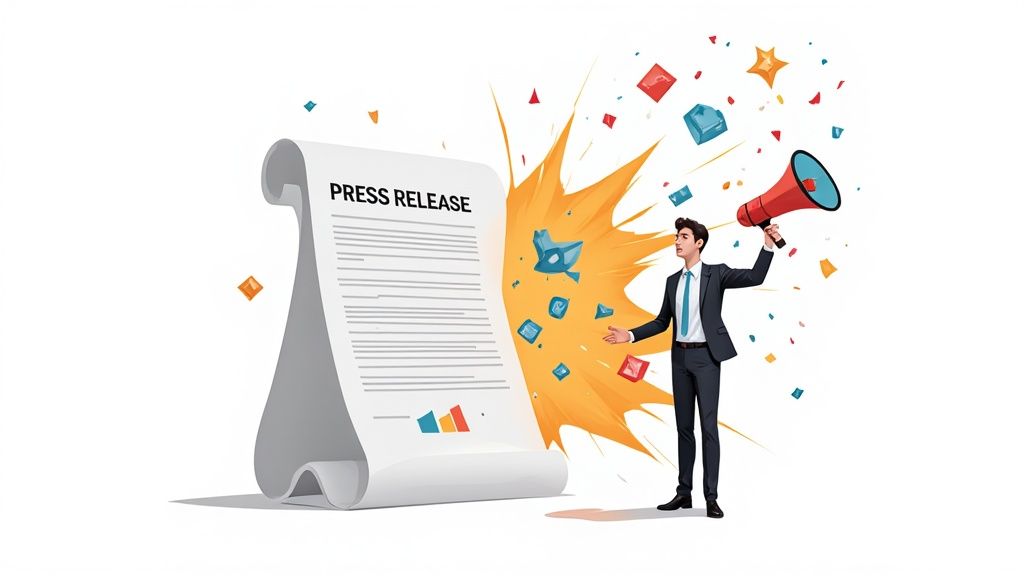Ready to Launch? 8 Strategies for a Killer Debut
Launching a new product? These eight proven new product launch strategies will help you make a splash. Whether you're a solopreneur, creator, career pivoter, coach, or purpose-driven professional, the right strategy is crucial for attracting clients and building a thriving business. Learn how to generate buzz, connect with your target audience, and achieve a successful launch. From market penetration to pre-launch buzz, we'll cover the tactics you need to make your debut a hit.
1. Market Penetration Strategy
Want to make a splash with your new product launch? A market penetration strategy offers a powerful pathway to rapid growth and brand recognition. This approach focuses on entering an existing market with a competitive price point, aiming to swiftly capture market share. Instead of trying to create a new need, you're satisfying an existing one – but better. This involves attracting customers away from established competitors by offering superior value, enhanced features, or more attractive pricing. Think of it as diving headfirst into the pool and making waves! This strategy is all about quickly establishing a significant presence and building your brand within a market where similar products or services are already available.

The market penetration strategy deserves a top spot in any list of new product launch strategies because it provides a clear, actionable roadmap for those seeking rapid growth. It’s particularly effective when you’re confident in your product's ability to outperform existing solutions and are prepared to invest in marketing to make a big initial impact. Its focus on competitive pricing, aggressive marketing, and high-volume output makes it a powerful tool for ambitious entrepreneurs, creators, and professionals ready to disrupt the status quo.
Key Features of a Market Penetration Strategy:
- Competitive or Lower Pricing: Position your product attractively compared to existing offerings.
- Aggressive Marketing and Promotion: Generate buzz and drive awareness through targeted campaigns.
- High-Volume Production and Distribution: Be ready to meet the anticipated demand.
- Focus on Customer Acquisition: Actively target customers currently using competitor products.
Pros:
- Faster Market Entry and Revenue Generation: See quicker returns compared to cultivating new markets.
- Leverages Existing Market Demand: Capitalize on pre-existing awareness and consumer need.
- Clear Competitive Benchmarks: Easily identify and position against the competition.
- Potentially Quicker ROI: Faster returns on your investment compared to slower-growth strategies.
Cons:
- Lower Profit Margins: Competitive pricing can squeeze profits, especially initially.
- Potential Price Wars: Aggressive pricing may provoke retaliatory responses from competitors.
- High Marketing Budget Required: Standing out requires significant investment in promotion.
- Success Hinges on Differentiation: Your product must offer a compelling advantage over existing options.
Inspiring Examples:
- OnePlus: Disrupted the smartphone market with high-spec phones at mid-range prices, luring customers away from premium brands.
- Amazon's Fire Tablets: Offered similar functionality to iPads at a significantly lower price point, gaining considerable market share.
- Xiaomi: Built a massive following by selling high-quality electronics at near-cost, prioritizing market penetration over immediate profits.
Actionable Tips for Implementation:
- Competitive Analysis is Key: Thoroughly research your competitors' pricing, features, and marketing strategies before setting your own.
- Highlight Your Unique Selling Proposition (USP): What makes your product truly stand out? Emphasize this in your marketing.
- Consider Introductory Pricing: Limited-time discounts can incentivize early adoption and generate buzz.
- Invest in Marketing that Communicates Value: Clearly articulate why your product offers better value than the competition.
When and Why to Use a Market Penetration Strategy:
This strategy is ideal when entering a market with established players and clear customer demand. It's particularly effective if you have a product that offers a significant advantage over the competition in terms of price, features, or both. If you’re a solopreneur, creator, or career pivoter looking to make a quick impact and establish your brand, market penetration could be your winning ticket. It allows you to leverage existing demand and build momentum quickly, especially if you're passionate about delivering exceptional value and are prepared to invest in strategic marketing. This approach requires a bold mindset and a willingness to compete aggressively, but the potential rewards are substantial.
2. Skimming Strategy
Want to launch your new product with a bang and establish it as the premium choice in the market? The skimming strategy might be your perfect launchpad. This approach involves setting a high initial price for your product to "skim" the profits from the top layer of the market—those early adopters who are willing to pay a premium for innovation, exclusivity, and the bragging rights of being first. Over time, as the initial hype subsides and you’ve captured that top segment, the price gradually decreases to attract more price-sensitive customers. This phased approach allows you to maximize profitability at each stage of the product lifecycle.
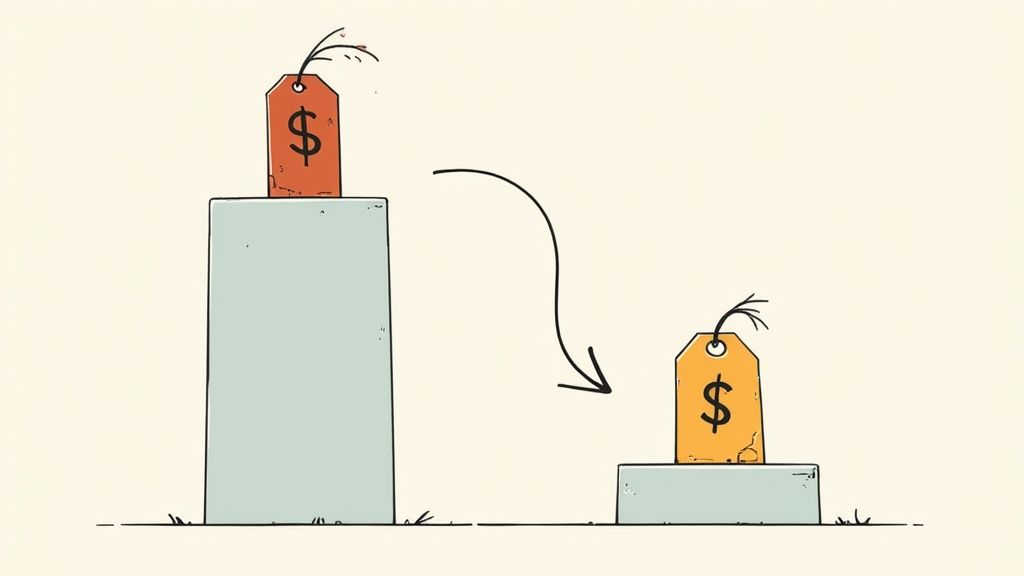
This new product launch strategy is incredibly powerful, particularly for solopreneurs, creators, and coaches looking to position their offerings as high-value. Imagine launching your online course or coaching program at a premium price, attracting those eager to learn from you and willing to invest in themselves. As your program gains traction and testimonials, you can then offer it at a lower price point, expanding your reach and impact. This not only generates early revenue but also establishes your brand as a leader in your field.
The skimming strategy works best when your product is truly innovative and stands out from the crowd. It's also highly effective if your brand already commands a strong following and perceived value that justifies the premium price tag. Think of Apple’s iPhone launches or Tesla's initial rollout of the Roadster and Model S. These products catered to early adopters who craved the latest technology and were willing to pay a premium for it.
Features of the Skimming Strategy:
- High initial pricing: This attracts the top tier of your target market and establishes a perception of exclusivity.
- Gradual price reductions: This expands your market reach over time as you capture more price-sensitive segments.
- Marketing focused on unique features and innovation: Highlighting what sets your product apart is crucial to justifying the premium price.
- Targeting early adopters and premium segments first: Focus your initial marketing efforts on those most likely to embrace your innovation.
- Phased approach to market expansion: Control your growth and scale your operations strategically as demand increases.
Pros:
- Higher profit margins in the early stages: Maximize your return on investment and fuel future growth.
- Creates perception of premium quality and exclusivity: Position your brand as a leader and attract high-value customers.
- Recovers R&D costs more quickly: Recoup your initial investment faster, allowing for further innovation.
- Allows time to scale production before mass market entry: Avoid being overwhelmed by demand and ensure a smooth rollout.
Cons:
- Smaller initial customer base and market share: Be prepared for a slower start in terms of overall market penetration.
- Risk of competitors entering with lower prices: A strong differentiation strategy is key to mitigating this risk.
- May create price sensitivity when lowering prices later: Careful planning and communication are essential to avoid customer backlash.
- Requires a truly differentiated product to justify the premium: The skimming strategy won't work if your product isn't truly unique or valuable.
Tips for Implementing the Skimming Strategy:
- Ensure compelling differentiation: Clearly articulate the unique value your product offers to justify the higher price.
- Plan your price reduction strategy: Avoid alienating early adopters by having a clear roadmap for price adjustments.
- Create exclusive features or editions for early adopters: Reward those willing to pay a premium with special perks.
- Use the high-margin period to perfect production and prepare for scaling: Invest early profits in optimizing your operations for future growth.
The skimming strategy is a powerful tool in your new product launch arsenal. By targeting the right audience, highlighting your unique value proposition, and carefully managing your pricing strategy, you can create a launch that not only generates revenue but also establishes your brand as a premium player in your market. Whether you’re a solopreneur launching a new service or a creator releasing a premium course, the skimming strategy can help you achieve your launch goals and build a thriving business.
3. Freemium Launch Strategy
The freemium launch strategy is a powerful approach for new product launches, particularly for digital products and services. It involves offering a core version of your product absolutely free, while reserving premium features, advanced functionality, or exclusive content for paying customers. This strategy lowers the barrier to entry, allowing potential customers to experience the value you offer without any initial financial commitment. The ultimate goal is to convert a portion of these free users into paying customers once they're hooked on the core offering and eager for more. This strategy is an excellent option among new product launch strategies because it fosters organic growth and builds a loyal user base.
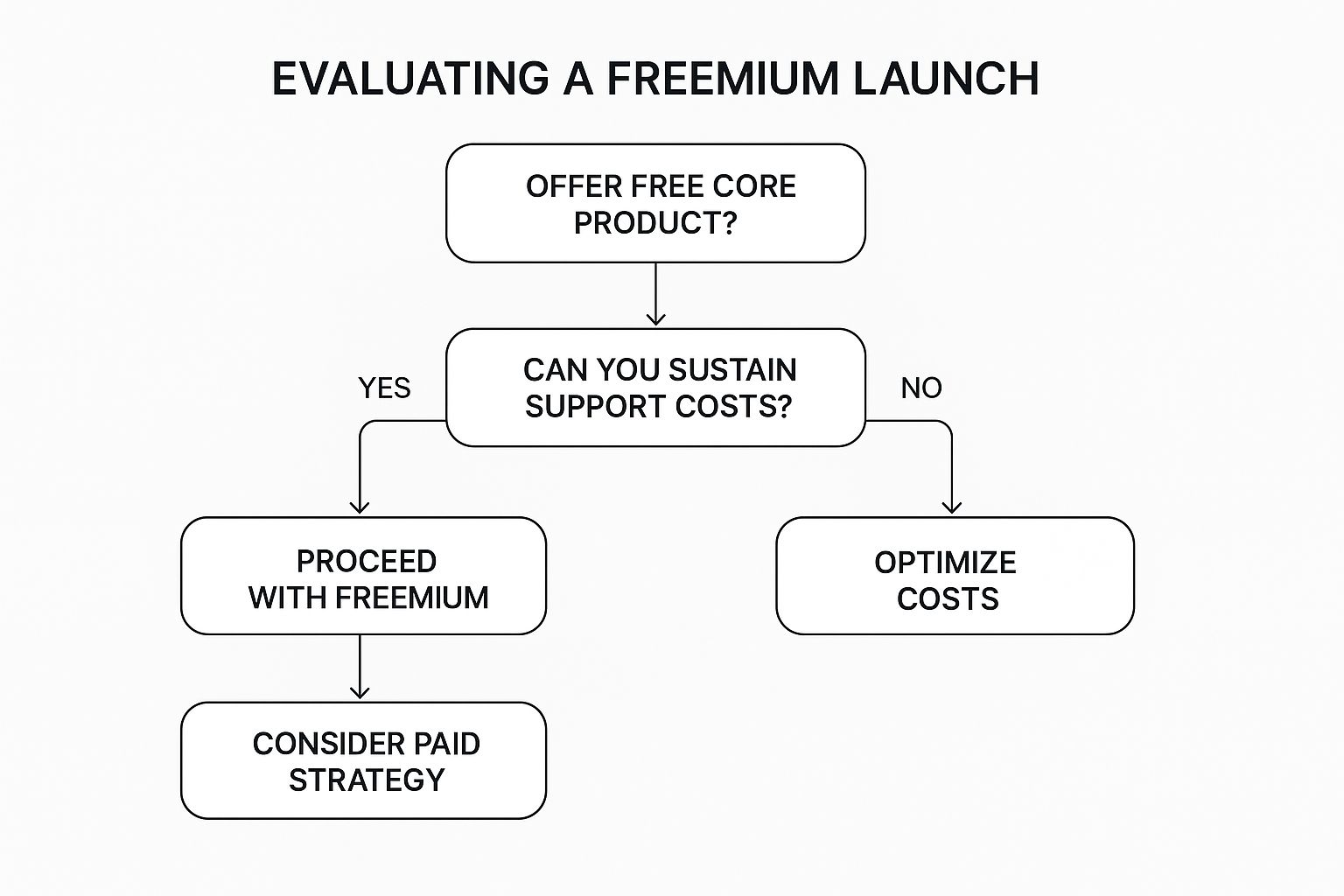
The infographic below presents a decision tree to guide you through the process of determining whether a freemium model is the right fit for your new product. It visualizes the key decision points and potential outcomes, allowing you to make informed choices for your launch strategy.
This decision tree starts by asking if your product has features easily divisible into free and premium tiers. If not, freemium is likely unsuitable. If yes, it then explores factors like your target audience's willingness to pay for premium features and your ability to handle the costs of supporting free users.
Features of a freemium launch include a free core product offering with paid premium upgrades, a focus on user acquisition before monetization, and a tiered pricing structure based on feature sets. The user experience is carefully designed to showcase the value of the premium features while still providing a satisfying experience for free users. Think Spotify offering free ad-supported streaming alongside its Premium tier, or Slack’s freemium model with limited message history for free users. Even Dropbox’s simple yet effective model of providing limited free storage with paid upgrades is a testament to the power of freemium.
The pros of this strategy are compelling: a lower barrier to entry facilitates rapid user acquisition, the potential for viral growth through free users expands your reach, and data collection from a large user base provides valuable insights for product improvement. Perhaps most importantly, it allows users to truly experience the value you offer before making a purchase.
However, the freemium model isn’t without its challenges. You need to convert enough free users to premium to ensure profitability. Balancing the value offered in the free version with the incentives to upgrade requires careful consideration. Managing server and support costs for a large base of non-paying users can also be a significant undertaking. And there’s always the risk that some users will be perfectly content with the free features, never feeling the need to upgrade.
For solopreneurs, aspiring creators, career pivoters, coaches, consultants, and purpose-driven professionals, the freemium model can be especially powerful. It allows you to build an audience, demonstrate your expertise, and generate leads without requiring upfront payment, making it easier to build trust and establish your brand.
Here are some actionable tips for implementing a successful freemium launch:
- Deliver Genuine Value (Free Tier): Ensure your free version delivers real value while clearly highlighting the benefits of upgrading to premium.
- Data-Driven Optimization: Use analytics to identify conversion triggers and optimize your upgrade prompts accordingly.
- Strategic Upgrade Prompts: Implement gentle upgrade prompts at key moments within the user experience, when users are most likely to perceive the value of premium features.
- Time-Limited Trials: Consider offering time-limited premium trials to allow users to experience the full power of your product.
Dropbox, which grew to over 500 million users via its freemium model, LinkedIn with its basic and Premium accounts, and Evernote, a pioneer of the freemium model for productivity apps, stand as inspiring examples of the potential of this launch strategy. Their success stories demonstrate how the freemium model can propel your new product to widespread adoption and establish a sustainable business. By carefully considering the decision points outlined in the infographic and implementing these tips, you can harness the power of freemium to launch your own product successfully.
4. Exclusive Partnership Launch Strategy
Imagine harnessing the power of an already established brand to catapult your new product into the spotlight. That's the magic of an exclusive partnership launch strategy. This powerful approach involves collaborating with another brand, retailer, or platform to introduce your product exclusively to their audience. By leveraging their existing customer base, distribution channels, and marketing muscle, you can generate significant buzz and achieve rapid market penetration. This strategy allows you to borrow credibility and trust from the established partner, instantly positioning your new product as something special and desirable. This creates a sense of scarcity and excitement, driving demand and building anticipation for a wider release.
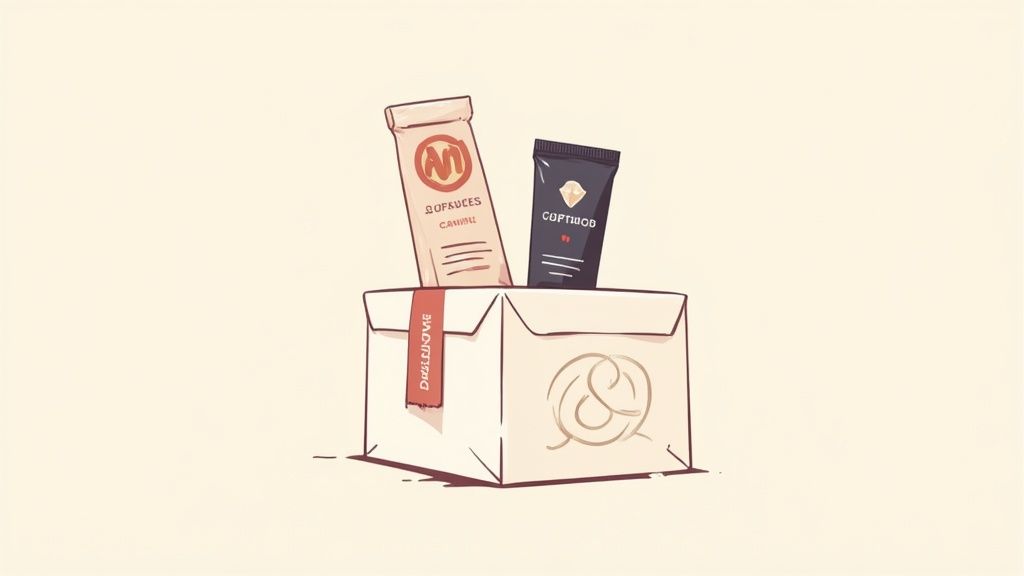
For solopreneurs, aspiring creators, career pivoters, coaches, consultants, and purpose-driven professionals, this new product launch strategy can be a game-changer. Are you a coach launching a new online course? Partnering with a well-known online learning platform gives you immediate access to their engaged audience of learners. Are you a consultant with a cutting-edge methodology? Teaming up with an industry-leading publication for an exclusive reveal can establish your expertise and attract high-value clients. This strategy provides the leverage you need to break through the noise and make a real impact.
This approach typically involves time-limited exclusivity with specific distribution partners and co-branded marketing efforts, maximizing the exposure to both audiences. Often, special editions or partner-specific features are created to enhance the exclusivity and appeal. Think of Apple Music launching initially only on Apple devices, creating a powerful synergy and incentivizing Apple device ownership. Similarly, beauty brands frequently launch new collections exclusively with Sephora or Ulta, leveraging their vast beauty-focused customer base.
Pros:
- Immediate access to an established customer base: Tap into a ready-made market, bypassing the initial hurdle of building an audience from scratch.
- Shared marketing costs and efforts: Pool resources and expertise, amplifying your reach and reducing your financial burden.
- Borrowed credibility and trust: Benefit from the partner's reputation and build trust with their audience.
- Creates newsworthy launch event and urgency: Generate excitement and drive sales through exclusivity and limited availability.
Cons:
- Limited distribution initially may constrain sales: Exclusivity can limit reach in the initial stages.
- Partner may demand favorable terms or revenue sharing: Negotiating mutually beneficial terms is crucial.
- Risk of being overshadowed by partner's brand: Ensure your brand maintains visibility within the partnership.
- Potential channel conflict when exclusivity ends: Careful planning is essential to manage the transition to wider distribution.
Tips for Success:
- Target Market Alignment: Choose partners whose audience closely aligns with your target market to maximize impact.
- Clear Terms: Negotiate clear terms regarding marketing support, placement, revenue sharing, and the exclusivity period.
- Exclusive Offerings: Create specific offerings or features exclusive to the partnership to enhance its value and appeal.
- Post-Exclusivity Plan: Develop a comprehensive strategy for the wider product release after the exclusivity period ends to maintain momentum.
Inspired by successful collaborations like Target's designer partnerships and Nike's exclusive athlete edition releases, the exclusive partnership launch strategy offers a powerful pathway to introduce your new product with a bang. By carefully selecting the right partner and structuring a mutually beneficial agreement, you can leverage their established platform to reach new heights and achieve remarkable results. This method deserves its place in this list because it provides a unique blend of immediate access, shared resources, and heightened brand awareness, making it a highly effective new product launch strategy.
5. Influencer-Driven Launch Strategy
Ignite your product launch with the power of influence! An influencer-driven launch strategy harnesses the already-established trust and engagement between influencers, thought leaders, or celebrities and their audiences to introduce your new offering. This strategy, a crucial component of modern product launch strategies, can catapult your product into the spotlight, generating buzz and driving sales from day one. It's especially impactful for those targeting specific demographics or communities where influencer recommendations hold significant sway, making it a must-consider approach for solopreneurs, aspiring creators, and career pivoters looking to make a splash.
How it Works:
This strategy focuses on authentic endorsements and real-world demonstrations from trusted voices. Instead of relying on traditional advertising, you're tapping into an existing network of engaged followers. This involves:
- Early product access for selected influencers: Give influencers a sneak peek and the opportunity to experience your product before anyone else.
- Content creation partnerships and sponsored posts: Collaborate with influencers to create compelling content showcasing your product in action.
- Influencer input during product development or customization: Leverage the influencer's expertise and understanding of their audience to refine your product or create tailored versions.
- Tiered approach working with macro and micro-influencers: Diversify your reach by partnering with a mix of influencers with varying audience sizes and engagement levels.
Why This Strategy Deserves Its Place in the List:
In today's digital landscape, consumers are bombarded with advertising. They crave authenticity and trust. Influencer marketing provides exactly that. It bridges the gap between traditional advertising and word-of-mouth marketing, delivering personalized recommendations directly to your target audience. For coaches, consultants, and purpose-driven professionals, this translates to attracting the right clients who resonate with your values and offering.
Features and Benefits:
- Leverages pre-existing trust: Influencers have cultivated strong relationships with their followers, who value their opinions and recommendations.
- Creates authentic, diverse content: Influencers can showcase your product in use in a way that feels genuine and relatable to their audience.
- Reaches highly targeted niche audiences efficiently: You can pinpoint specific demographics or communities through carefully chosen influencer partnerships.
- Often generates higher engagement than traditional advertising: Influencer content tends to be more engaging than generic ads, leading to increased brand awareness and purchase intent.
Examples of Success:
- Glossier: Built their entire brand through influencer partnerships, turning everyday beauty enthusiasts into brand ambassadors.
- Daniel Wellington: Leveraged Instagram influencers to grow rapidly, becoming a global watch phenomenon.
- Gymshark: Achieved explosive growth through collaborations with fitness influencers, creating a loyal community around their brand.
- Fenty Beauty: Rihanna's following and a diverse group of influencers propelled the brand's launch to immense success.
Pros and Cons:
Pros: High engagement, targeted reach, authentic content, leverages pre-existing trust.
Cons: Costly for top-tier influencers, risk of influencer controversy, difficult to measure results precisely, potential for audience fatigue.
Actionable Tips for Implementation:
- Choose influencers whose authentic interests align with your product: Authenticity is key. Partner with influencers who genuinely believe in your product and whose audience aligns with your target market.
- Provide creative freedom rather than rigid talking points: Allow influencers to showcase your product in a way that feels natural and resonates with their audience.
- Complement influencer content with trackable offers and landing pages: Make it easy for followers to purchase your product by providing direct links and special offers.
- Create an influencer tier strategy mixing celebrity, macro, and micro-influencers: Diversify your reach and budget by partnering with a mix of influencers at different levels.
Popularized By:
Brands like Fashion Nova, Bang Energy drinks, and Morphe cosmetics demonstrate the power of influencer marketing, from rapid growth through Instagram to saturating TikTok and building through beauty YouTuber partnerships. This emphasizes the versatility and potential of this strategy across different platforms and industries.
By strategically incorporating an influencer-driven launch into your new product launch strategies, you can harness the power of authentic connection and propel your product to success. This strategy is especially valuable for solopreneurs, aspiring creators, career pivoters, coaches, and consultants looking to establish a strong brand presence and connect with their ideal audience.
6. Phased Rollout Strategy: Test the Waters, Conquer the Ocean
Launching a new product can feel like taking a giant leap of faith. The Phased Rollout Strategy offers a safer, more controlled descent – a way to test the waters before diving headfirst into the ocean. This powerful new product launch strategy involves introducing your offering incrementally, whether to different customer segments, geographic regions, or even specific features at a time. This measured approach minimizes risk, maximizes learning, and allows you to refine your product based on real-world feedback before reaching full market saturation. It's the smart choice for solopreneurs, creators, career pivoters, coaches, consultants, and purpose-driven professionals alike, seeking to make a meaningful impact with their new venture.
How it Works: Imagine unveiling your masterpiece, not all at once, but piece by piece, gathering valuable insights along the way. A phased rollout might begin with a beta program for a select group of users, followed by expansion to a specific city or demographic. As you gather data and feedback, you can tweak your product, messaging, and even your target audience, ensuring a stronger, more impactful final launch.
Features of a Phased Rollout:
- Controlled Release: Limit your initial launch to a manageable group.
- Feedback Loops: Establish systems for gathering data and user feedback between phases.
- Progressive Scaling: Gradually increase production, support, and marketing efforts as you expand.
- Pilot Programs: Utilize beta programs and early access opportunities to gain crucial insights.
Why This Strategy Deserves Its Place: In a world saturated with noise, a phased rollout offers a strategic advantage. It allows you to build anticipation, refine your offering, and scale sustainably. This approach is particularly valuable for those building service businesses, launching online courses, or introducing a new coaching program.
Pros:
- Risk Mitigation: Contain potential problems to smaller groups, preventing widespread issues.
- Product Refinement: Use real-world feedback to optimize your product and messaging before a full launch.
- Scalable Growth: Manage production, support, and marketing more effectively by scaling gradually.
- Multiple PR Opportunities: Generate buzz and excitement with each phase of your rollout.
Cons:
- Longer Launch Timeline: Reaching full market potential takes more time.
- Competitive Pressure: Competitors may enter untapped markets during your rollout.
- Management Complexity: Juggling different product versions or messaging can be challenging.
- Market Frustration: Customers in later-phase markets may experience a sense of delay.
Inspirational Examples:
- Facebook: Initially launched exclusively to Harvard students before expanding to other colleges.
- Tesla: Mastered controlled production ramps for each new vehicle model.
- Starbucks: Regularly tests new beverages and food items in select markets before nationwide release.
Actionable Tips for Implementation:
- Strategic Segmentation: Choose initial markets or audiences that represent your ideal customer.
- Formal Feedback Mechanisms: Implement surveys, feedback forms, and social listening tools to gather data.
- Transparent Communication: Keep your audience informed about the rollout timeline to manage expectations.
- Adaptive Planning: Be prepared to pause or adjust the rollout if significant issues arise.
When to Use a Phased Rollout:
- Complex Products or Services: When your offering requires extensive testing and refinement.
- Limited Resources: When scaling production or support is a significant challenge.
- High-Risk Launches: When the potential consequences of a failed launch are substantial.
The Phased Rollout Strategy empowers you to navigate the complexities of a new product launch with confidence. By embracing a measured, data-driven approach, you can mitigate risk, optimize your offering, and build a sustainable foundation for long-term success. It's not just about launching a product; it's about creating a movement, one phase at a time.
7. Disruptive Pricing Strategy: Shake Up the Status Quo and Capture a Market
Are you ready to challenge industry norms and make a real splash with your new product launch? A disruptive pricing strategy can be your secret weapon. This powerful approach goes beyond simple discounts; it fundamentally reimagines how customers perceive value and how they pay for it. By dramatically lowering price points or introducing unconventional pricing models, you can unlock vast untapped markets and position your product as a game-changer. This strategy deserves a place in any entrepreneur's toolkit because it offers a unique pathway to rapid growth and market dominance.
What is it and how does it work?
A disruptive pricing strategy isn't about being the cheapest; it's about offering unprecedented value. It’s about making a product or service accessible to a segment of the market that was previously priced out, effectively expanding the entire market. This can be achieved through various innovations, like shifting from ownership to subscription models, streamlining your business model to drastically reduce costs, or leveraging technology to deliver value in a new, more efficient way. The goal is to not just compete within an existing market, but to reshape it entirely. Think accessibility, affordability, and a total shift in customer expectations.
Examples of Disruptive Success:
- Netflix: Remember Blockbuster? Netflix disrupted the video rental industry by introducing a subscription model that offered unlimited movies for a flat monthly fee, decimating the late fees and inconvenience of traditional rentals.
- Robinhood: Commission-free stock trading? Unthinkable before Robinhood. They democratized investing by removing the financial barrier to entry for millions.
- Warby Parker: By cutting out the middleman and selling directly to consumers, Warby Parker offers stylish eyewear at a fraction of the price of traditional retailers, shaking up the entire eyewear market.
- Dollar Shave Club: Their subscription model for razors delivered convenience and affordability directly to your door, significantly undercutting established giants like Gillette.
Actionable Tips for Implementation:
- Cost Structure is Key: Before you announce a disruptive price, ensure your business model can genuinely support it. Rigorous financial modeling is crucial.
- Value Proposition Focus: Don't just shout about the low price. Highlight the overall value your product delivers. What problems are you solving? What benefits are you offering?
- Secure Funding: Disruptive pricing often requires significant upfront investment to achieve scale and profitability. Secure adequate funding to weather the initial period.
- Path to Profitability: Chart a clear path to profitability and communicate it transparently to investors. This demonstrates a long-term vision beyond the initial disruption.
When and Why to Use This Strategy:
This strategy is ideal for solopreneurs, aspiring creators, career pivoters, coaches/consultants, and purpose-driven professionals looking to:
- Differentiate: Stand out in a crowded marketplace.
- Capture a New Audience: Reach customers who were previously unable or unwilling to buy.
- Establish Market Leadership: Become the go-to provider in a newly defined market segment.
- Drive Rapid Growth: Benefit from the network effects of quickly expanding your user base.
Pros & Cons:
Pros:
- Strong Differentiation: A compelling narrative that attracts attention and sets you apart.
- Rapid Market Expansion: Access new customer segments and achieve significant growth.
- Competitive Advantage: Makes it difficult for established players to respond without cannibalizing their existing business.
- Network Effects: Rapid user growth can create a virtuous cycle of increased value and further growth.
Cons:
- Unsustainable Economics: Requires careful planning and execution to avoid financial pitfalls.
- Funding Dependence: Often requires significant investment to reach profitability.
- Price Wars: Risk of triggering price wars, especially if your model is easily replicated.
- Difficulty Raising Prices Later: Can be challenging to increase prices once a low price point has been established.
Disruptive pricing isn't for the faint of heart. It requires vision, meticulous planning, and the courage to challenge conventional wisdom. But for those who dare to disrupt, the rewards can be transformative. By redefining value and making your product accessible to a wider audience, you can ignite exponential growth and achieve lasting success. Remember, it’s not about being the cheapest, it’s about offering unprecedented value and transforming the market landscape.
8. Pre-Launch Buzz Strategy: Ignite Excitement Before You Even Launch
Want to create a wave of anticipation that crashes down on launch day, driving sales and establishing your offering as the must-have? Then a pre-launch buzz strategy is your secret weapon. This powerful approach within new product launch strategies centers around building excitement, awareness, and demand before your product or service even hits the market. It's about turning curiosity into craving, and transforming potential customers into eager buyers.
Imagine the roar of a crowd before a concert begins – that electric energy is what a pre-launch buzz strategy creates. By strategically teasing your audience with glimpses of what’s to come, you cultivate a sense of anticipation and FOMO (fear of missing out) that drives strong initial sales, organic word-of-mouth marketing, and media coverage.
How it Works: The Mechanics of Buzz
This strategy leverages a carefully orchestrated pre-launch marketing campaign that includes controlled releases of information. Think sneak peeks, behind-the-scenes glimpses, and tantalizing hints about the benefits your offering will bring. Key tactics include:
- Waitlists, Pre-orders, and Reservations: Generate a sense of exclusivity and gather valuable customer data before you even launch. This also provides early validation and potential cash flow.
- Exclusive Previews: Offer special access to media, influencers, or early supporters, creating a ripple effect of excitement and positive reviews.
- Content Marketing that Builds Category Awareness and Need: Position yourself as a thought leader and demonstrate the problem your offering solves, priming your audience for the solution you're about to unveil.
Examples of Buzz Done Right:
Think Apple’s masterfully executed product announcements months before availability, building suspense and generating headlines worldwide. Or consider Kickstarter campaigns, where communities coalesce around a product before it even exists. Even Tesla has leveraged pre-launch buzz, generating thousands of pre-orders for new vehicle models based on anticipation alone. These are prime examples of how a pre-launch buzz strategy can create a frenzy of excitement and translate directly into sales.
Actionable Tips to Build Your Buzz:
- Create a Content Calendar: Map out a strategic timeline for revealing information, ensuring a steady drip of exciting content that keeps your audience engaged.
- Offer Meaningful Incentives: Reward early waitlist sign-ups or pre-orders with exclusive discounts, bonus content, or early access.
- Nurture Your Audience: Develop an email nurture sequence to maintain engagement and build relationships with potential customers until launch day.
- Use Scarcity Ethically: Generate FOMO by offering limited editions or early-bird pricing, but ensure transparency and avoid manipulative tactics.
Why This Strategy Deserves its Place in the List (and in Your Toolkit):
For solopreneurs, aspiring creators, career pivoters, and purpose-driven professionals, a pre-launch buzz strategy is a game-changer. It helps you:
- Establish Authority & Credibility: Showcase your expertise and build trust by offering valuable content and insights before your product/service launches.
- Gain Early Traction: Generate leads, gather feedback, and validate your offering before investing heavily in production or marketing.
- Control Your Narrative: Shape the conversation around your launch and position yourself as a leader in your niche.
- Maximize Your Launch Impact: Create a surge of demand and drive immediate sales on day one, setting the stage for long-term success.
Pros & Cons:
Pros: Creates demand and sales pipeline pre-launch, generates valuable customer data, provides potential cash flow, and sets up a successful launch day.
Cons: Risk of overpromising, extended exposure of plans to competitors, challenge of maintaining momentum if launch delays occur, and potential for unrealistic expectations.
A pre-launch buzz strategy isn't just about generating hype – it's about building a community of excited customers ready to embrace your offering. It's about creating a launch so powerful, it resonates long after the initial excitement fades. Use it wisely, and watch your launch soar.
New Product Launch Strategy Comparison
| Strategy | Implementation Complexity 🔄 | Resource Requirements ⚡ | Expected Outcomes 📊 | Ideal Use Cases 💡 | Key Advantages ⭐ |
|---|---|---|---|---|---|
| Market Penetration Strategy | Medium – aggressive marketing needed | High – marketing & production | Rapid market share gain, faster ROI | Existing markets with competition | Quick revenue, leverages known demand |
| Skimming Strategy | Medium – staged pricing and marketing | Medium – R&D, premium marketing | High early margins, brand exclusivity | Innovative or premium products | High profit margins, recovers R&D quicker |
| Freemium Launch Strategy | High – product tiers & user support | High – ongoing support & analytics | Viral growth, gradual monetization | Software/apps with scalable user base | Low entry barrier, data driven improvements |
| Exclusive Partnership Launch | Medium – partner negotiations | Medium – shared marketing | Immediate customer access, brand trust | New products seeking credibility & focused reach | Shared costs, exclusive access |
| Influencer-Driven Launch | Medium to High – influencer management | Medium to High – partnerships | High engagement, niche targeting | Products targeting communities with influencers | Authentic marketing, targeted reach |
| Phased Rollout Strategy | High – multi-phase planning | Medium – scaled production & marketing | Reduced risk, product refinement | Complex products or limited production capacity | Risk mitigation, gradual scale-up |
| Disruptive Pricing Strategy | High – business model innovation | High – funding & cost management | Market expansion, competitive disruption | Underserved segments, markets needing innovation | Strong differentiation, rapid user growth |
| Pre-Launch Buzz Strategy | Medium – prolonged campaign planning | Medium – marketing & content | Strong launch demand, early sales pipeline | Products benefiting from hype and anticipation | Builds excitement, early customer data |
Launching with Confidence: Your Next Steps
From market penetration to pre-launch buzz, we've explored a range of powerful new product launch strategies. The key takeaway? There's no one-size-fits-all approach. Whether you're a solopreneur building a service business, a creator finding your audience, a career pivoter launching a new venture, a coach refining your brand, or a professional seeking more purpose, the perfect launch strategy aligns with your unique goals and target audience. Mastering these concepts allows you to not just launch a product, but to launch it with intention, maximizing your impact and reaching the right people with the right message.
Once your product launches, driving consistent growth becomes paramount. To further accelerate your product launch and overall business growth, explore these proven ecommerce growth strategies from ECORN. They offer valuable insights into scaling your business after the initial launch phase.
Remember, a successful product launch isn't just about the initial splash—it's about building momentum and creating a lasting impact. By carefully selecting and implementing the right strategies from this article, you can position your product for long-term success. Now, go make some noise and launch with confidence!
Ready to streamline your launch process and create a cohesive brand experience from the very beginning? Henri Den can provide the tools and resources you need to plan, execute, and analyze your new product launch strategy. Visit Henri Den today to discover how we can help you launch smarter, not harder.
